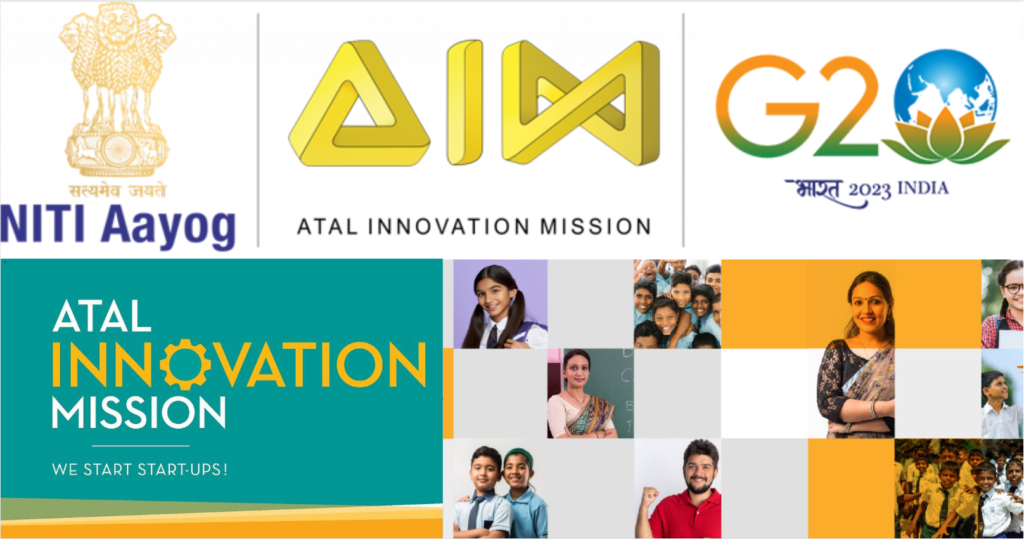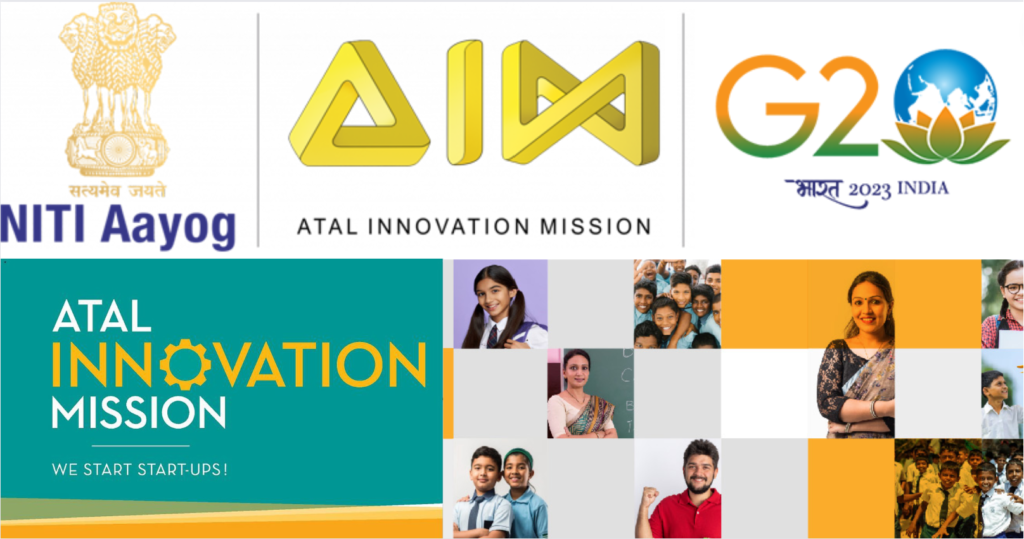Atal Innovation Mission:- The Government of India’s premier effort to create an innovative and entrepreneurial culture throughout the whole nation is the Atal Innovation Mission (AIM). The goal of AIM is to build new policies and programmes that encourage innovation across the economy, give various stakeholders a platform and opportunities for collaboration, and establish a centralized organisation that will manage the nation’s innovation and entrepreneurship ecosystem. Read the complete post to get complete information related to Atal Innovation Mission including Highlights, Objectives, Achievements, Activities, Application Process, and much more

What is Atal Innovation Mission ?
The NITI Aayog launched the flagship Atal Innovation Mission (AIM) to encourage entrepreneurship and innovation throughout the nation. The program was launched in response to talks and a thorough analysis of India’s requirements in the areas of innovation and entrepreneurship in the years to come. The establishment and promotion of an ecosystem of innovation and entrepreneurship at various levels, including Higher Secondary Schools, Science, Engineering, and Higher Academic Institutions, SME/MSME industry, Corporate, and NGO levels, will be encouraged by AIM’s significant role in bringing innovation policies from Central, State, and Sectoral Innovation Schemes into alignment.
AIM’s long-term goals include revitalising science and technology innovations at the nation’s major research institutions, such as the Council of Scientific and Industrial Research (CSIR), the Institute of Agribusiness Research (ICAR), and the Institute of Medical Research (ICMR), in line with the needs of the country’s socioeconomic sector. These efforts will be coordinated through the establishment of Small Business Innovation Research and Development (AIM-SBIR) for SMEs, MSME, and start-ups.
Top 10 Government Startup Schemes
Startup India Seed Fund Scheme
Stand Up India Loan Scheme
Credit Guarantee Scheme for Startups
AIM Mission Details in Highlights
| Name | Atal Innovation Mission |
| Initiated by | Government of India |
| Launched by | NITI Aayog |
| Objective | to create an innovative and entrepreneurial culture throughout the whole nation |
| Official Website | https://aim.gov.in/index.php |
Atal Innovation Mission Objective
- Innovation is the main focus. As a result, plans and policies for many different industries will be based on that idea.
- It gives options for collaboration and a platform for multiple parties to work together.
- It acts as a supervising body that manages and protects the whole innovation ecosystem in the nation.
Achievements of Atal Innovation Mission
Some of the key achievements of Atal Innovation Mission are as follows:
- In order to support the expansion of the nation’s innovation ecosystem, more than 350 collaborations have been formed.
- The National Association of Software and Services Companies (NASSCOM), in collaboration with the AIM, has developed an artificial intelligence-based curriculum for students in school.
- Over 2.5 million children now have access to the nearly 5000 Atal Tinkering Labs spread throughout 660 Indian districts.
- AIM created Mentor India, one of the biggest mentoring networks in India.
- At least half of the more than 10,000 mentors who have signed up have firsthand experience working with startups and ATLs.
AIM Mission Activities
Some of the key activities of Atal Innovation Mission are as follows:
- Atal Tinkering Labs (ATLs): In order to foster children’s imagination and creativity and to improve their skill sets in computation thinking, design, physical computing, and adaptive learning, AIM creates Atal Tinkering Laboratories (ATLs) in schools. ATLs give kids the resources and apparatus they need to learn and comprehend STEM (science, technology, engineering, and math) ideas. Additionally, ATLs sell kits and equipment covering a range of subjects, such as computers, sensors, electronics, and 3D printers. ATLs are designed for students in grades 6 to 10 and are located in schools overseen by the government, local governments, private trusts, and society. With an initial establishment cost of Rs. 10 lakh and ongoing operating costs of Rs. 10 lakh over a five-year period, AIM gives each school financial help totaling Rs. 20 lakh.
- Atal New India Challenge (ANIC): Encouraging innovation in the fields of energy, water, housing, health, and hygiene is the goal of AIM. ANIC creates its own framework and mechanisms for MSMEs’ and startups’ technologies and goods. ANIC supports the development of goods for social objectives using current technologies. ANIC’s focus areas include food processing, electric mobility, housing, power and energy, water and sanitation, agriculture, mobility, health, and education.
- Atal Incubation Centres (AICs): AICs, which assist and encourage start-up businesses to become more stable, scalable, and sustainable, are supported by AIM. In every state and industry across the country, AIM supports women-led incubators and entrepreneurial start-ups. For successful applicants, the mission gives funds of up to Rs. 10 crores to establish greenfield incubators. AICs will be set up in a number of topic-specific domains, such as manufacturing, agriculture, education, water, energy, health, transportation, and sanitation. Suitableness.Applicants must give AIM at least 10,000 square feet of built-up, usable area in order to use AICs. AICs can be utilised by R&D centres, corporate entities, business accelerators, individuals, and higher education organisations, among others.
- Atal Community Innovation Centre: The Atal Community Innovation Centre concentrates on disadvantaged and underprivileged areas of the country that do not currently have an environment supporting innovation and startups.
- Mentor of Change Program: In order to provide student mentorship at ATL and ATC incubators and start-ups, AIM has established mentoring networks among the Indian professional sector. There are about 5000 mentors who are registered and in line with the active ATL. It is mandatory for mentors to dedicate at least one to two hours per week to one or more laboratories. In addition, the mission collaborates with creative organisations and systems in the US, UK, Latin America, Africa, Asia-Pacific, and Europe.
Atal Innovation Mission’s Struggles
India is the biggest democracy in the world. With more than a billion people, 33 states, eight union territories, and a variety of languages, each region has unique challenges to meet in terms of cultural expectations and economic growth. Future innovators must be made aware of the importance and breadth of these problems. Therefore, it is imperative to provide incentives for innovative thinking and pertinent problem solving at the municipal, state, and federal levels nationwide – in educational institutions, businesses, and even internationally.
The Atal Tinkering Challenges in educational institutions. Incentives will come from the Atal Grand Challenges at the national level and the Atal New India Challenges for startups and universities. An incentive like this would encourage the establishment of new markets as well as the solution of pertinent problems and inventions and entrepreneurship that can find ready consumers. Challenges include drinking water and sanitation, urban housing and development, smart agriculture in the face of climate change, rail safety and transportation, and other sectors where product innovations can benefit the nation while also generating profits. The most recent Atal Tinkering Marathon had over 35,000 students participate, producing over 6000 innovations in five nationwide competitions.
Application Process for Atal Innovation Mission
- Sending invitations to candidates via an online application portal: Schools have between three and four months to complete their online ATL applications. Schools can submit their ATL applications online with ease thanks to the user-friendly ATL online application portal.
- Screening of applications: The applications that were received would be processed using the eligibility criteria. A minimum number of students enrolled, committed maths and science teachers, a basic infrastructure with computers and internet access, a consistent electrical supply, a science lab, a library and a playground, as well as staff and student attendance on a regular basis, are some of the requirements for eligibility. The qualifying candidate schools will be ranked and evaluated based on these criteria.
- Final Evaluation: More arbitrary standards are used to evaluate the school’s dedication to leveraging the ATL as a springboard to transform itself into a regional centre of innovation. After the final review, a list of selected schools is made available on the AIM website. The amount of money allotted and the consent of the relevant authorities decide how many ATLs are chosen and publicised at any one time. The schools must complete the compliance process, which is described in the following section, in order to be eligible for the grant-in-aid.




